Follow US:
Four new sighting of the Tasmanian Tiger (Thylacine) have been reported in the last three months (2006) on the outskirts of Portland, Southern Australia. These along with the recent discovery of rock paintings in Western Australia depicting what appears to be several thylacines, suggest the Tasmanian Tiger used to roam across most of mainland Australia, and poses the question of whether the Tasmanian tiger is really extinct!
Cryptoword would love to hear from anybody who thinks they have seen a Thylacine in the last 12 months, or believes they know where they can been found, as we are thinking of planning an expedition to Australia and Tasmania next year, and would like to spend some time searching for the Tasmanian Tiger. Contact Cryptoworld.
Tasmanian tiger ‘sightings’
TASMANIAN tigers are said to be roaming the outskirts of Portland.
Four sightings of one of the world’s most fabled creatures have been reported to an independent researcher in the past three months.
The last sighting was in early May by a Portland resident, Anthony Ersello, who said yesterday he saw the strange dog-like animal sitting in the middle of the Princes Highway on the outskirts of town near the Shell service station.
“I’d been walking home from a party, had one beer and was walking home when I saw it on the road sitting in the middle of the intersection. It kept staring into the distance and then looked at me,” Mr Ersello said.
The animal had a pointed face, chunky shoulders, stripes and its hind was long and lean.
“I wanted to take a photo with my phone but it had been raining and the wet road made a reflection. I got to about 15 metres then it ran into the bushes.”
“I didn’t know what it was. It looked like a bit of a dog but it didn’t really look like one.”
Another Portland resident, who did not want to be identified, reported two separate thylacine sightings in the past year and believed the tigers regularly crossed farms and pups had been spotted.
The sightings have excited researcher Michael Moss, who is preparing to visit Portland with two infra-red cameras in an attempt to capture the creatures on film.
Mr Moss, who has researched thylacines for a decade, said it was possible the animals had originated from thylacines released into Gippsland early last century.
He said a 1912 management report for Wilsons Promontory suggested the introduction of the tigers, along with other native animals.
However no documentation confirms the animals were released despite the first sightings reported in Gippsland in 1915.
With a spate of sightings in Nelson and Portland’s latest claim to fame, Mr Moss said it was possible the introduced species may have moved west.
The Portland sightings are across a two to three kilometre area and Mr Moss said records showed it was not unusual for the animals to come to a town’s edge.
Source: Tasmanian tiger `sightings (Warrnambool Standard)

Tassie tiger art on rocks in ruckus
NEW evidence that Tasmanian tigers once roamed Australia’s mainland has come to light in the world’s largest concentration of rock art, adding weight to calls for its legislative protection.
Twelve rock carvings of the extinct thylacine have been found on the Burrup peninsula, a rugged 20km-long expanse on the northwest Pilbara coast of Western Australia.
The discoveries by archaeologist Ken Mulvaney, some made as recently as last month, double the number of thylacine images found among ancient Aboriginal rock carvings scattered across 2000 Burrup sites. As many as 300,000 individual drawings, featuring animal and human figures, have been etched into boulders.
The Australian revealed on Thursday that the state Government had lodged strong opposition to proposed National Heritage listing to protect the rock art. It had cited “grave consequences” for Australia’s largest resource project, the North West Shelf LNG plant, and other projects on the peninsula.
But Mr Mulvaney, who is also president of the Australian Rock Art Research Association, said the rock art needed urgent legal protection from industrial expansion and acid rain that was eroding rock surfaces.
“You cannot say any of the art is safe, and we don’t know what other carvings are out there because no survey has been done in areas earmarked by the WA Government for industrial estates,” he said.
Mr Mulvaney said it was cultural vandalism to continue promoting industry in an area where the world’s greatest rock art had been created over a 20,000-year period.
“The Burrup continues to reveal highly significant petroglyphs, both in a scientific and aesthetic sense,” he said.
A spokesman for federal Heritage Minister Ian Campbell, who was overseas, said the minister would “take all views into account” before making his decision in September on Burrup’s listing.
The Tasmanian tiger is believed to have roamed widely across Australia up until about 3000 years ago. Around that time – perhaps because of the arrival of the dingo – it disappeared from the mainland, surviving only in dingo-free Tasmania until the last thylacine died in 1936 in Hobart Zoo.
Professor Iain Davidson, head of the University of New England’s archeology department, said Mr Mulvaney’s discoveries were important evidence that thylacines lived on the mainland and that Aborigines interacted with them.
But saving it did not mean industry had to leave the Burrup. “The best way to protect heritage is to work with industry and government to make sure they understand how important it is,” he said, adding that a recent decision by LNG partner Woodside to audit the heritage assets on its Burrup sites was “a good start”.
Source: Tassie tiger art on rocks in ruckus (The Australian)
External Links:
Naturalworlds.org – thylacine
Advertisements

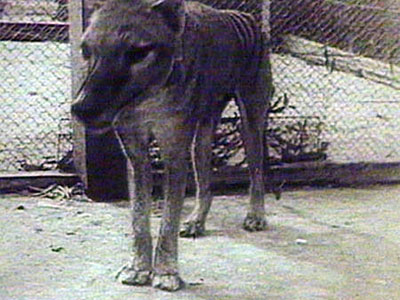
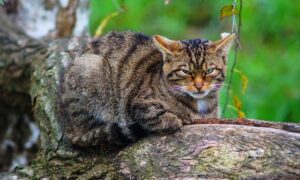
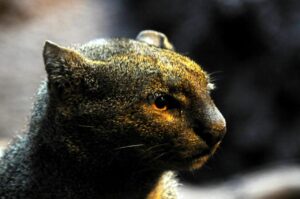
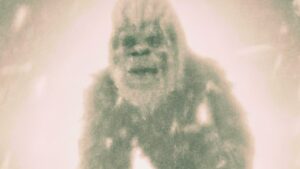
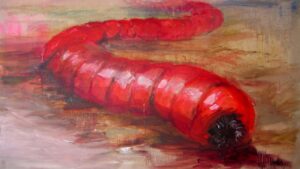
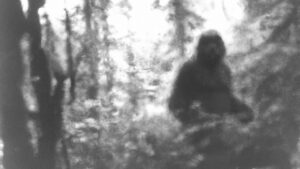


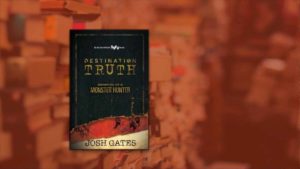
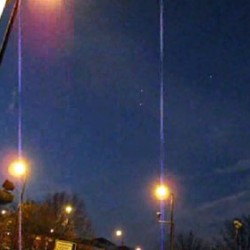


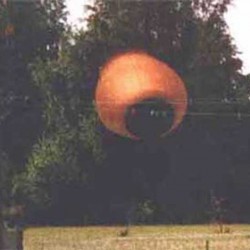
Portland is actually in Victoria.
Leongatha (east of Melbrourne) is a good place to start.
Yet to meet anyone from there that has not had a sighting or have friends or family who have seen it.
Hi Scott, thanks for the info.
I think we are definitely going to make a trip to Australia next year, part vacation part expedition. So the more the merrier on the information front.
umm very intresting and good information for school projects and speeches aswell this site made it easier to understand certain things about the tasmanian tiger/thylacine a good website for those who are intresed in the thylacine
the information needs to be clearer to understand what actually occurred during the possible sighting/s. Actual sightings have not been reported on the mainland for years, causing people to believe that the animal may actually be extinct. By the way, anyone wanting to visit Victoria, and in particular Melbourne, needs to make sure they visit The Esplanade Hotel in St Kilda. The food is great!
Sarah, thanks for your comment and the plug — when I visit Australia, which is on the cards for next year, I will defiantly check out the Esplanade.
If I was planning an expedition to Australia to look for the tiger I wouldn,t even bother with the mainland I am from Tasmania there are alot of people around the west coast who claimed to have seen them but they are to old school around here to report it they would rather you left them alone but there is a lot of land in Australia that hasnt been touched in 50 years or more thats where I would start In the deepest thickest bush you can find and take care mate alot of people get lost in our forests they are quite unpredictable like random vertical drops and from hot sun to freezing and raing in five minutes
je ne pense pas ke les thylacines ont disparus!!souvenez vous ke meme au 19 siècle ou ils étaient pas encore classés animal disparu ils étaient vrémant difficile à voir now ils sont juste plus rares é plus peureux!!Thylacines are alive!!
these thylacine sightings are another good example of demonic activity.this is no different from bigfoot and big cat sightings. the demons can take on any form that they choose.
would really like to hear from des who was on forum about tasmanian tiger
strange thig des. we have had a two encounters with a thylacine.i have spiritual decernment and believe that both times it was actually a demonic possesion. people may laugh, but ive been to new guinea and know some of the things witchdoctors and the like get up to, and its not uncommon over there.us white folk are just a little naive on this subject and tend to put it down to too many drinks or whatever.but it is true! i could take people over there and show them things right before their eyes that would scare the #### out of them.
Forget the demon b.s. Tigers may still hold on in both the mainland and Tasmania. Lot’s of sightings never reported in Tasmania, trust me. I believe from several sightings relayed to me, the Tiger definitely existed into the 1970s. These sightings are not in the literature.
i found thyacines good many years back yet to get a good photo but i have many prints long pads some of my other research was given to the quest for thylacoleo .com dont asked me where i saw it until the goverment of aust signs a document with tribal land councils to protect and put my people in charge of this program .
Hi tiger fans and happy new year.I have downloaded onto youtube a 15 part series on my tasmanian tiger and big cats search-research which may be of interest.Go to youtube index and enter mjmoss66 .cheers .Ps For whats its worth i do not believe there are tasmanian tigers in tasmania.
Last summer my wife and I were driving in central QLD as we were in the Monto area going north
at about 5pm we saw what looked like a large dog crossing in front of our car from right to left,we had to slow down from 100kl to about 75 kl as it just ambled across in front of us and did a sideways glance and then dissapered into the scrub on the left side of the road.
The so called dog was about the size of a german shepard but was very thin around the gut it also had a long tail that was out of keeping of a normal dog plus it was possum colured dark on top to a grey underneath very large head (looked like some sort of gargoyal in apperance)and a big chest and cat like ears and no whites around the eyes it also did not seem worried about the preasance of the car.
i do beleive that what we saw was a thyacines
Travelling from Queensland to Victoria in December 2010 my daughter and I had camped the night at Seal Rocks, about 200kms north of Sydney, and we were driving west through Myall Lakes National Park back toward the Pacific Highway at about mid-morning. Light rain and a narrow unfamiliar road through a heavily forrested area meant I was driving at approx 80 kph when we both saw it. As it moved off the gravel on the left hand side of the road, up the embankment towards the bush it stopped and looked at us as we passed. The striped flanks and the skulking posture of the longish body tripped an alarm immediately. Almost casually I asked my daughter did she the Thylacine and she said she saw a dog with mud plastered on its back. I didn’t stop to investigate, partly because of the car travelling directly behind us on this narrow road, but moreso because of the diffuculty my brain had processing the relevance of this puzzleing encounter.Months later I can’t reconcile a dog- wild,domestic or feral- covering it’s back end with mud as my daughter postulated. In all my years I’ve never witnessed anything so extraordinary. I believe I saw Thylacine that day.
When I was approx. 13 my father & I saw an unusual animal which later turned out to be incredibly close to the tasmanian tiger (cute little stripes & all). What struck me was the incredible speed at which this animal (when it saw me approaching), bolted. It seemed comparable to some of the quickest dogs I have seen. eg greyhounds.
A few years later I had another sighting of a creature which was eating a dead rabbit. It was the unusually shaped head, which made me curious. Later when I explained what I had seen, others in our area had stories from the 50’s, when these animals would walk into camp sites seeking out food. If anyone is interested, the location was in the Riverland South Australia, North East of Adelaise (S.A’s capital). I still believe I was lucky enough to have two seperate sightings.
I remember when I was 8 we were setting rabbit traps around lunch time on a big property at Blanchetown SA there was a big hill and up the top I saw a big animal with stripes walking my uncle took a shot with his 22 and it bolted we ran up the hill to find nothing it was bare landscape with a few trees scattered around first thought for me and others was a skinny tiger I’m 36 now
[…] strange predators still survive in the remote Australian wilderness. There are occasional sighting reports as well as potential tracks, scat and kills, although none can be definitely said to be those of a […]
I live in Tasmania… and I KNOW they are not extinct… they are still roaming around if you know where to look….
On the west cost of Tasmania… there is a family of tigers at Lofty Range… I have seen them a few times, as I grow my pot down that way.. 😉
They don’t even really look like tigers, as their back half is striped, and the front half is the same as a dog… no mystery here, just Tassie wildlife….
….what real hardcore evedence have you found, just sightings and pictures arn’t relyable enough. when you get real DNA, hair samples, bodys, then people will believe you but for now your just another loser without proof trying get attention. :p
In am now 74 years of age and know without any doubt that i saw a genuine Thylacine in 1980 on a return trip to Tasmania from western Australia.
Although i would need to retrace steps i know approximately where i saw the animal which was on the verge of a pine forest between MT Gambier and Victioria, Although i was driving i had an excellent view of this animal.
I am now too old to be concerned what people think and would be willing to take a lie detector test as to the voracity of my statement.
That’s great news, Don. I live in the Eastern US, and wildlife officials scoffed for years about pumas. Nah, they didn’t exist, right? Well, my cousin saw one in the Adirondacks in Upstate NY, early 2000’s, maybe. Cougars are repopulating old haunts. I know if I saw a cougar, I’d probably keep pretty quiet about it, as I wouldn’t want people to shoot it. Maybe that’s why people in Taz keep quiet. I wish the thylacine had another population so that if (as many of you have reported) they still exist, they’d not pass into oblivion because of inbreeding/small population.
I’m pleased to hear of the sighting in South Australia ! because i know without any doubt that it was a thylacine that i saw on or about the South Australia / Victorian border in 1980 on my return to Tasmania from Western Australia.and never reported it for fear of being ridiculed.
I am most willing to subject to a lie detector test in order to be believed.
don davey.
About three months ago me my partner and friend was traveling along the digby road in victoria heading to Geelong it was roughly about 5:30 am,the sun was just starting to come up my paeter was driving and I was awake my friend was asleep me and my partner spotted this big black cat type animal
run across the road and following after it was its baby it was bigger then a fox and it was black as it was to quick to be a cat,dog or fox and its baby was even to big to be a normal domestic house hold cat,dog or even fox it was pure black with a silky coat it had beautiful light blue eyes.we are still possitive that it was a panther or tiger